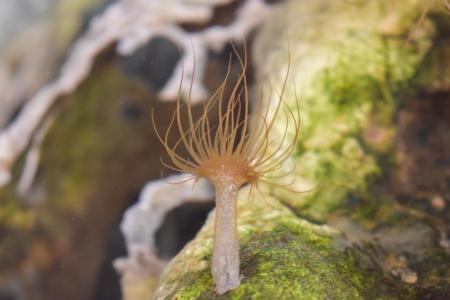Dec 22 2020
Researchers can now use the CRISPR/Cas9 genome editing system to gain insights into, and perhaps enhance, the response of corals to the environmental stresses caused by climate change.
 Aiptasia photograph. Image Credit: Purchased from Shutterstock.
Aiptasia photograph. Image Credit: Purchased from Shutterstock.
Led by Phillip Cleves—who joined Carnegie’s Department of Embryology this fall—the study describes how the groundbreaking, Nobel Prize-winning technology can be used to steer conservation efforts aimed at vulnerable reef ecosystems.
The findings of the research team headed by Cleves were published recently in two papers in the Proceedings of the National Academy of Sciences.
Corals are marine invertebrates that create widespread calcium carbonate skeletons from which reefs develop. However, this architecture is only viable due to a mutually beneficial relationship between the coral and different species of single-celled algae that live within individual coral cells.
These algae transform the energy from the sun into food through a process known as photosynthesis. Moreover, they share a portion of the nutrients they generate with their coral hosts—somewhat like paying rent.
Coral reefs are of immense economic, aesthetic and ecological value. Several communities rely on them for food and tourism. But human activity has impacted on coral reefs in the form of pollution, acidification and warming oceans, thus affecting the symbiotic relationship.
In particular, increasing ocean temperatures can cause coral to lose their algae, a phenomenon called bleaching, because the coral takes on a ghostly white look in the absence of the algae’s pigment. Without the nutrients provided by photosynthesis, the coral can die of starvation.
Phillip Cleves, Department of Embryology, Carnegie Institution for Science
In 2018, Cleves led the team that showed the first use of the CRISPR/Cas9 genome editing on coral. At present, his teams employed CRISPR/Cas9 to find the gene that regulates the response of the coral to heat stress.
Studying the anemone Aiptasia first, one of teams—which included Cory Krediet, Erik Lehnert, Masayuki Onishi, and John Pringle from Stanford University—found a protein, known as Heat Shock Factor 1 (HSF1), which triggers several genes related to the response to heat stress.
Although anemones are close relatives to corals and have analogous symbiotic relationships with photosynthetic algae, they grow much quicker and are easier to examine. Thanks to these traits, Aiptasia is a robust model system to investigate coral biology in the lab.
The other team led by Cleves and including Amanda Tinoco and John Pringle from Stanford University, Jacob Bradford and Dimitri Perrin from Queensland University of Technology, and Line Bay from the Australian Institute of Marine Science (AIMS) employed CRISPR/Cas9 to develop mutations in the gene that encodes HSF1 in the coral Acropora millepora, showing that it is significant for coping with a warming environment.
With the lack of a functioning HSF1 protein, the coral perished very fast with an increase in the temperature of the surrounding water.
Understanding the genetic traits of heat tolerance of corals holds the key to understanding not only how corals will respond to climate change naturally but also balancing the benefits, opportunities and risks of novel management tools.
Line Bay, Principal Research Scientist and Head, Reef Recovery, Restoration and Adaptation Team, Australian Institute of Marine Science
“Our work further demonstrates how CRISPR/Cas9 can be used to elucidate aspects of coral physiology that can be used to guide conservation. This time we focused on one particular heat tolerance gene, but there are so many more mechanisms to reveal in order to truly understand coral biology and apply this knowledge to protecting these important communities,” concluded Cleves.
Journal Reference:
Cleves, P. A., et al. (2020) Insights into coral bleaching under heat stress from analysis of gene expression in a sea anemone model system. Proceedings of the National Academy of Sciences. doi.org/10.1073/pnas.2015737117.